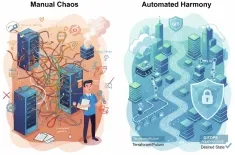Learn to treat APIs as products, implement security standards, and leverage the integration layer for revenue growth.
The digital world is built on connections. In this hyper-connected landscape, Application Programming Interfaces (APIs) have transcended their traditional technical role to become the fundamental building blocks of modern business strategy. They are the conduits for data exchange, service integration, and innovation across companies, partners, and customers. This shift has given rise to the **API economy**, a transformative business model where APIs are not just technology components, but valuable, revenue-driving assets.
At its core, the **API economy** is defined by the commercial exchange of capabilities and data through APIs. Companies leverage their core business functions—like payment processing, geolocation data, or communication services—and package them as consumable APIs. This allows them to create new revenue streams, foster strategic partnerships, and accelerate digital transformation. However, treating these digital assets as tradable commodities, especially **external APIs** offered to third parties, introduces significant complexity and risk, making robust **API governance** an absolute necessity.
Treating APIs as Products: Driving Revenue and Innovation
The most profound paradigm shift in the **API economy** is the move toward **Treating APIs as products**. This approach means an API is managed with the same rigor and strategic vision as a physical or software product.
Product Management for Digital Assets
For an API to drive revenue effectively, it must solve a customer's problem. This requires applying product management principles to the API lifecycle:
- Market Research: Understanding the needs of the target consumers (developers, partners, internal teams). What capabilities are valuable? What platforms do they use?
- Design and UX: Focusing on a consistent, easy-to-use developer experience (DX). This includes clear documentation, predictable behavior, and robust testing.
- Versioning and Evolution: APIs must evolve without breaking existing integrations. A structured approach to versioning is key to maintaining customer trust and minimizing disruption.
- Monetization: Implementing a structured **monetization strategy** to capture the value the API provides.
This product-centric view is essential for developing a strong **monetization strategy**. APIs can generate revenue through various models:
- Pay-per-use: Charging a fee for each API call, common for high-value data or transaction services.
- Tiered Subscriptions: Offering different access limits, features, and service-level agreements (SLAs) at various price points.
- Revenue Sharing: Partner APIs where the provider takes a percentage of the revenue generated by the partner's integrated service.
- Value-Added Services: Offering enhanced support, analytics, or consulting services alongside the API access.
By framing APIs as products, an organization shifts its mindset from cost center to profit driver, unlocking new markets and partner ecosystems.
API Governance: The Cornerstone of the API Economy
The moment an organization decides to expose its capabilities—whether internally to its own departments or externally as a revenue-generating asset—it must implement strict governance. **API governance** is the set of established rules, standards, processes, and tools that ensure the entire API lifecycle aligns with the organization's business objectives, regulatory requirements, and technical capabilities.
Without governance, an organization faces API sprawl—a chaotic proliferation of inconsistent, undocumented, and unsecured APIs. This creates technical debt, slows down innovation, and critically, exposes the business to massive security risks.
Essential Pillars of API Governance
Effective governance is built on several key pillars that apply equally to APIs intended for **external and internal consumption**:
Security Standards and Risk Mitigation
**Security standards** are arguably the most critical component of **API governance**. APIs are the primary entry point to an organization's most valuable assets: its data and its core business logic.
- Authentication and Authorization: Enforcing rigorous protocols like OAuth 2.0 and OpenID Connect. Governance dictates how access tokens are issued, validated, and managed.
- Data Protection: Ensuring all data in transit and at rest meets industry and regulatory requirements (e.g., GDPR, CCPA, HIPAA). This includes mandates for encryption and masking sensitive information.
- Threat Protection: Implementing policies for rate limiting, bot detection, and Web Application Firewall (WAF) integration to guard against common attacks like injection, DDoS, and API abuse. Governance ensures that every API, regardless of its purpose, adheres to the defined baseline **security standards**.
Design and Consistency
Governance mandates consistency in design. This includes:
- Standardized Naming Conventions: Uniform resource paths and field names to enhance discoverability and reduce developer friction.
- Protocol Consistency: Choosing and enforcing standards like REST, GraphQL, or gRPC for different use cases.
- Error Handling: Defining standard, informative error codes and response formats so developers can reliably build failure-handling logic.
Consistency not only improves developer productivity but also enhances the overall quality and maintainability of the API ecosystem.
Lifecycle Management and Versioning
APIs, as products, have a lifecycle—from design and initial release to deprecation and retirement. Versioning is a governance requirement that manages this evolution.
- Non-Breaking Changes: Policies defining what constitutes a minor change (e.g., adding an optional field) that doesn't require a new major version.
- Deprecation Policy: Clear, documented rules for how long older versions will be supported after a new version is released. This provides consumers with a predictable window to migrate, which is crucial for maintaining relationships with users of **external APIs**.
- Documentation: Mandatory, up-to-date documentation (e.g., OpenAPI specification) throughout the lifecycle, ensuring that consumers always know how to use the current version.
Compliance and Regulatory Alignment
In many industries, APIs must comply with strict regulations. **API governance** ensures that all APIs meet these mandates, whether it's Open Banking regulations in finance or data residency requirements in cloud environments. A strong governance framework includes auditability and logging to demonstrate compliance to regulatory bodies.
The Integration Layer: Where Governance Meets Technology
The realization of the **API economy** and the enforcement of **API governance** happen at the **integration layer**. This layer, often managed by an API Management Platform or API Gateway, sits between the API consumers and the backend services.
API Gateway and Management Platform
The API Gateway is the control point where governance policies are implemented and enforced. It is a critical piece of the technology stack for both **external and internal consumption** of APIs.
- Policy Enforcement: The gateway enforces the **security standards** defined in the governance model (e.g., validating API keys, token authentication, and rate limiting).
- Traffic Management: It controls the flow of requests, ensuring high availability, load balancing, and enforcing the limits set by the **monetization strategy** (e.g., blocking requests from users who have exceeded their quota).
- Mediation and Transformation: It can transform requests and responses to maintain consistency, allowing the backend services to remain decoupled from the public API contract.
- Monitoring and Analytics: The gateway provides the data necessary to monitor API performance, identify abuse, and track usage for billing, a key part of the **monetization strategy**.
The **integration layer** is where the strategic business decisions of the **API economy**—like who gets access and how much they pay—are translated into technical reality under the strict mandate of **API governance**.
Conclusion: The Future of Digital Business
The **API economy** is no longer a fringe trend; it is the dominant mode of digital operation. Companies that successfully **Treat APIs as products** are unlocking unprecedented opportunities for growth and innovation. This commercialization, however, mandates a non-negotiable prerequisite: strong **API governance**.
From defining the **monetization strategy** for **external APIs** to ensuring adherence to critical **security standards** across the **integration layer**, **API governance** provides the structure and control necessary to maximize API value while mitigating catastrophic risks. Organizations that view governance not as a bureaucratic burden, but as a strategic enabler of speed, scale, and security, will be the leaders of the next wave of digital business transformation. A clear, consistent, and well-enforced governance model is the bedrock upon which a successful and sustainable **API economy** presence is built.



































